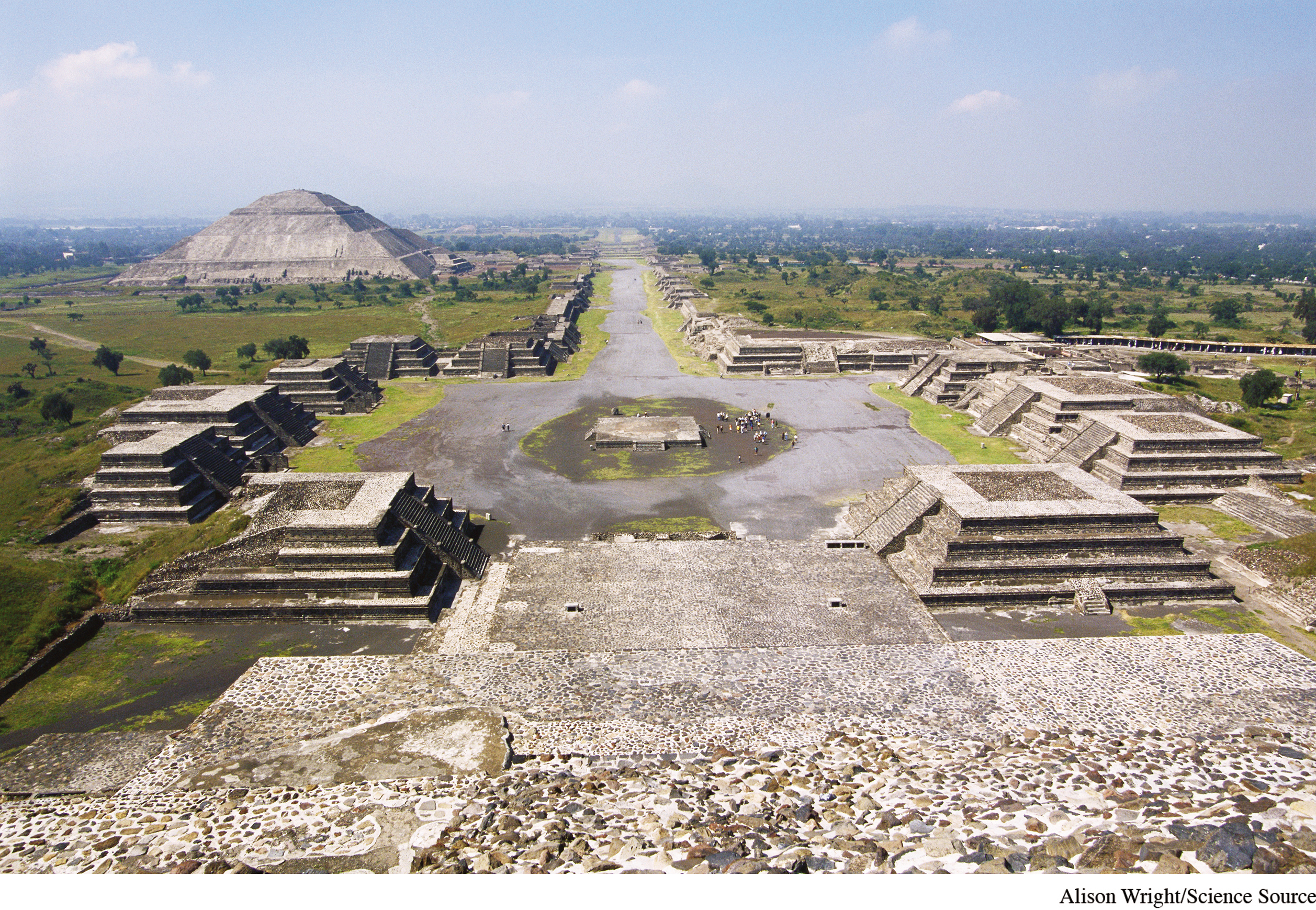Teotihuacán: The Americas’ Greatest City
At roughly the same time as the Maya flourished in the southern regions of Mesoamerica, the giant city of Teotihuacán (tay-uh-tee-wah-KAHN) was also thriving further north in the Valley of Mexico. Begun around 150 B.C.E. and apparently built to a plan rather than evolving haphazardly, the city came to occupy about eight square miles and by 550 C.E. had a population variously estimated between 100,000 and 200,000. It was by far the largest urban complex in the Americas at the time and one of the six largest in the world. Beyond this, much about Teotihuacán is unknown, such as its original name, the language of its people, the kind of government that ordered its life, and the precise function of its many deities.

Teotihuacán Taken from the summit of the Pyramid of the Moon, this photograph looks down the famous Avenue of the Dead to the Pyramid of the Sun in the upper left. (Alison Wright/Science Source)
In what ways did Teotihuacán shape the history of Mesoamerica?
Physically, the city was enormously impressive, replete with broad avenues, spacious plazas, huge marketplaces, temples, palaces, apartment complexes, slums, waterways, reservoirs, drainage systems, and colorful murals. Along the main north/south boulevard, now known as the Street of the Dead, were the grand homes of the elite, the headquarters of state authorities, many temples, and two giant pyramids. One of them, the Pyramid of the Sun, had been constructed over an ancient tunnel leading to a cave and may well have been regarded as the site of creation itself, the birthplace of the sun and the moon. At the Temple of the Feathered Serpent, archeologists have found the remains of some 200 people, their hands and arms tied behind them; they were the apparently unwilling sacrificial victims meant to accompany the high-ranking persons buried there into the afterlife.
Off the main avenues in a grid-like pattern of streets lay thousands of residential apartment compounds, home to the city’s commoners, each with its own kitchen area, sleeping quarters, courtyards, and shrines. In these compounds, perhaps in groups of related families or lineages, lived many of the farmers who tilled the lands outside the city. Thousands of Maya specialists—masons, leather workers, potters, construction laborers, merchants, civil servants—also made their homes in these apartments. So too did skilled makers of obsidian blades, who plied their trade in hundreds of separate workshops, generating products that were in great demand throughout Mesoamerica. At least two small sections of the city were reserved exclusively for foreigners.
Buildings, both public and private, were decorated with mural paintings, sculptures, and carvings. Many of these works of art display abstract geometric and stylized images. Others depict gods and goddesses, arrayed in various forms—feathered serpents, starfish, jaguars, flowers, and warriors. One set of murals shows happy people cavorting in a paradise of irrigated fields, playing games, singing, and chasing butterflies, which were thought to represent the souls of the dead. Another, however, portrays dancing warriors carrying elaborate curved knives, to which were attached bleeding human hearts.
The art of Teotihuacán, unlike that of the Maya, has revealed few images of self-glorifying rulers or individuals. Nor did the city have a tradition of written public inscriptions as the Maya did, although a number of glyphs or characters indicate at least a limited form of writing. One scholar has suggested that “the rulers of Teotihuacán might have intentionally avoided the personality cult of the dynastic art and writing” so characteristic of the Maya.8 Perhaps those rulers constituted an oligarchy or council of high-ranking elites rather than a single monarch.
However it was governed, Teotihuacán cast a huge shadow over Mesoamerica, particularly from 300 to 600 C.E. A core region of perhaps 10,000 square miles was administered directly from the city itself, while tribute was no doubt exacted from other areas within its broader sphere of influence. At a greater distance, the power of Teotihuacán’s armies gave it a presence in the Maya heartland more than 600 miles to the east. At least one Maya city, Kaminaljuyú in the southern highlands, was completely taken over by the Teotihuacán military and organized as a colony. In Tikal, a major lowland Maya city, in the year 378 C.E., agents of Teotihuacán apparently engineered a coup that placed a collaborator on the throne and turned the city for a time into an ally or a satellite. Elsewhere—in the Zapotec capital of Monte Albán, for example—murals show unarmed persons from Teotihuacán engaged in what seem to be more equal diplomatic relationships.
At least some of this political and military activity was no doubt designed to obtain, either by trade or by tribute, valued commodities from afar—food products, cacao beans, tropical bird feathers, honey, salt, medicinal herbs. The presence in Teotihuacán of foreigners, perhaps merchants, from the Gulf Coast and Maya lowlands, as well as much pottery from those regions, provides further evidence of long-distance trade. Moreover, the sheer size and prestige of Teotihuacán surely persuaded many, all across Mesoamerica, to imitate the architectural and artistic styles of the city. Thus, according to a leading scholar, “Teotihuacán meant something of surpassing importance far beyond its core area.”9 Almost a thousand years after its still-mysterious collapse around 650 C.E., the great metropolis was dubbed Teotihuacán, the “city of the gods,” by the peoples of the Aztec Empire.
